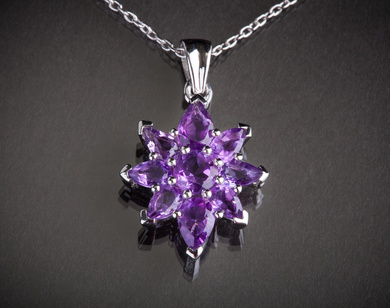What Is Amber?
Amber is a tree resin that fossilized over tens of millions of years in the earth, where it matured under high temperature and pressure.

Amber bracelet
Today, amber is extracted from rocks or collected when it is washed up onshore by the sea.
Amber is a very soft material and has been used in jewelry, medicine, and perfumery since ancient times.
Types of Amber
A common classification of amber is according to its origin.
Nowadays, there are two main areas where most amber is found: The Baltic region and the Dominican Republic.
There are also deposits in other parts of the world, but they are relatively small compared with the ones in those two major regions.
Baltic Amber
This type of natural amber is over 40 million years old and is one of the most valuable. It can be transparent or opaque and occurs in light to dark tones of yellow.
The opaque variety of Baltic amber can also be white.
Dominican Amber
Amber coming from the Dominican Republic is between 25 and 40 million years old. This type of amber is more likely than the Baltic variety to have insects or plants trapped inside.
Much like Baltic amber, Dominican amber can be seen in various tones of yellow, but it also comes in blue and green varieties, which are found only in this region and are very rare.
How to Value Amber Jewelry
The value of amber is mainly determined by its color and clarity. Some collectors also place a higher value on pieces that have fossils inside them.
Color of Amber
In general, the most valuable color of amber is rich yellow of medium to strong darkness. Red pieces are also considered of high value.
The most important quality that determines the value of amber’s color is its intensity.
Clarity of Amber
Clear amber is more valuable than pieces that look cloudy or opaque. Dominican amber tends to have higher clarity compared with most Baltic amber specimens.
Plant pieces captured in amber can be considered inclusions, but they do not really diminish its value and can add to its attraction.
Amber Treatments
Here are the most common treatments used to improve the appearance of natural amber:
Heat
Amber can be heated in oil to improve color and clarity.
This is especially true of Baltic amber, which is often treated this way before it is sold. Red Baltic amber, in particular, is almost always heated to achieve its cherry color.
The color of Dominican red amber, in contrast, is usually natural.
A lot of the green amber sold today also owes its color to treatment.
Filling
Some amber pieces have cracks and other irregularities, which are masked by filling them with copal (another form of tree resin).
Coatings
Some amber is also covered with certain coatings. This type of treatment usually aims to enhance color, but the results are not as durable as those of heat treatment.
Melting
Since amber pieces are not always the right size or shape that consumers prefer, vendors melt pieces of the material into chunks that are larger or better shaped.
The resulting pieces are called “pressed amber.” This type of amber is cheaper than comparable solid pieces.
What Is Fake Amber?
Fake amber pieces are usually made of copal, other resins, plastic, and even glass. It is not always easy to distinguish imitations from the real thing as some of them look very much like genuine amber.
One of the surest ways to identify real amber is to touch it with a hot needle – the smell produced should be sweet and pine-like. However, this is test is not recommended unless you are ready to damage a part of your amber.
Copal is probably the most commonly used imitation material since it is also a tree resin, just like amber, only younger and less mature.
Although it looks very similar to amber, copal is softer and can be scratched with a fingernail, which should not leave a mark on amber.
Contrary to what many people think, trapped beetles or bees inside an amber piece do not guarantee that it is authentic – sometimes, sellers insert these insects themselves.
The most certain and harmless way to test whether a piece is genuine amber is to use a scientific method such as IR-spectroscopy or spectrometry.
Baltic Amber: What It Is and How to Establish Its Value
Baltic amber refers to amber found not only in the Baltic region but also in parts of Germany, Russia, and Poland.
This type of amber is more than 40 million years old and contains succinic acid, which is the reason that Baltic amber is also referred to as “succinite.”
The value of Baltic amber is determined mainly by its color.
Clarity also plays a role, although the relationship between it and price is not always straightforward.
Treatments to improve Baltic amber’s appearance are pretty common and do not necessarily diminish its value.
Let’s take a look at each of these factors in detail:
The Color of Baltic Amber
The most common color of Baltic amber is light to medium-dark yellow (usually described as lemon-like or honey-like).
There are darker varieties that have more brownish or reddish hues, and some pieces are even white and opaque. Baltic amber with blue or green hues also exists, but such pieces are very rare.
The most valuable Baltic amber colors are honey, cognac, and red. In general, more intense hues are preferred, and paler colors are not as valuable as more saturated ones.
Baltic Amber Clarity
Baltic amber varies in clarity, and pieces can range from transparent to fully opaque. Usually, clearer pieces are preferred to those of lower clarity.
However, flaws in amber are not necessarily seen as problematic, and if they indicate that a piece is authentic and ancient, they may make it more valuable.
For example, amber with captured insects or plants inside can be sold at a premium (unless the piece is fake, which is often the case).
Treatments of Baltic Amber
Baltic amber is often treated to make its color more saturated or to improve its clarity, and such procedures do not make it any less authentic.
These treatments are very common and make it possible to buy amber that looks great at an affordable price.
The most common method used to enhance the appearance of amber is heating, which usually yields lasting results.
However, you should keep in mind that other ways of improving amber’s hue, such as covering the piece with various colored coatings, are not permanent.
There is the so-called pressed Baltic amber, which is created by melting smaller pieces of amber and fusing them together to form a bigger piece.
The resulting amber pieces are cheaper than comparable solid ones of the same size, but pressed amber is also less robust when it comes to resistance to pressure.
Fake Baltic Amber
Fake Baltic amber is often made of copal, which is a tree resin that is not old enough to have become real amber.
Glass, plastic, or some non-amber resins are also used to make imitations. It is, however, very hard to detect some of these fakes.
The most straightforward test to check whether an amber piece is fake is to burn part of it (e.g., by touching it with a hot needle) and see if it gives off the characteristic pine-like smell of tree resin.
However, since burning also damages amber permanently, this kind of testing is not really practical. Therefore, the best way to see if amber is genuine is to have it tested by a professional using special equipment.
To minimize the possibility that you might buy a fake, look for some telltale signs that an amber piece is not authentic.
First of all, any Baltic amber that seems too cheap is probably not genuine.
If the cheap piece also has some trapped objects such as insects inside, then it is almost certainly fake (very often, these “captured” bees or beetles were simply put in, and this also happens with expensive pieces).
Picking Settings for Amber Jewelry
Amber gemstones complement silver, white and yellow gold metals.
If you prefer casual settings that complement your funky fashion style, choose silver or white gold chains, bracelets, or ring settings.
Yellow gold is suitable for any of the colors in this gemstone as well. If you prefer this type of metal, it is quite becoming with the stones that range in the lemon, butterscotch, cognac, or brown shades often found in amber stones.
What to Wear with Amber Jewelry
The warm colors of the stones work well with autumn shades or neutrals, such as khaki, beige, or brown. Depending on the setting, this jewelry is perfect for dressy or casual wear.
If you adore dressing in bohemian fashions, this stone is definitely for you, although it can be classy and elegant with the right setting and fashion ensembles.















